|
It is undeniable that once a person reaches a certain stage in life there is a strong urge to recall the accomplishments of ones lifetime. Martin L. Kaiser, Inc. has been around for 50 years and Marty Kaiser, a lot longer. The format of this page is not set yet so let's see what happens. Check in periodically for new additions. Marty
NOTE: NONE OF THE PRODUCTS ON THIS PAGE ARE FOR SALE... THIS IS HISTORICAL INFORMATION ONLY! |
 The 3075 portable, battery operated, receiver system centered around a variety or receivers and transmitters. One version was produced with a Regency multi channel crystal
controlled receiver and included a matching, or several matching, crystal controlled transmitters. Another 3075 system included a tunable
Lafayette Radio MICRO-P50 or MICRO-P150 receiver and several transmitter such as the RT5, TT5 and
BT50. When Lafayette Radio discontinued the P50 and P150, I produced my own receivers known as the R-200PA/50 (shown in the picture) and R-200/150. The right side of
the metal sub chassis housed a variety of standard or long play cassette recorders. The center console contained a mixer with provision for up to three microphones.
Switchable excitation voltage was available at each microphone jack to power external amplifiers and accessories. There was also a 1/2 watt power amplifier and loudspeaker.
Six "C" cells powered the 3075 that was contained in a standard 3 1/2 inch American Tourister attache case. The 3075 portable, battery operated, receiver system centered around a variety or receivers and transmitters. One version was produced with a Regency multi channel crystal
controlled receiver and included a matching, or several matching, crystal controlled transmitters. Another 3075 system included a tunable
Lafayette Radio MICRO-P50 or MICRO-P150 receiver and several transmitter such as the RT5, TT5 and
BT50. When Lafayette Radio discontinued the P50 and P150, I produced my own receivers known as the R-200PA/50 (shown in the picture) and R-200/150. The right side of
the metal sub chassis housed a variety of standard or long play cassette recorders. The center console contained a mixer with provision for up to three microphones.
Switchable excitation voltage was available at each microphone jack to power external amplifiers and accessories. There was also a 1/2 watt power amplifier and loudspeaker.
Six "C" cells powered the 3075 that was contained in a standard 3 1/2 inch American Tourister attache case.
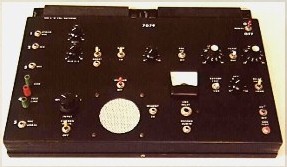

The Mason A2 and A3, CEI RS-111 and Microtel countermeasure receivers were simply too expensive for most nonfederal customers. The 6060 was developed to provide a low priced alternative to these products. In spite of its simplicity it had some interesting features. A Sprague 610 Interference Locator was modified with a wide band I.F. to drive a Heathkit spectral display. The unit also included a sub-carrier demodulator. The most unique part was the 6060UHF high frequency down converter. It contained an adjustable 200 MHz comb generator and 5 GHz mixer that took the entire 5 GHz down to 200 MHz in 200 MHz chunks! 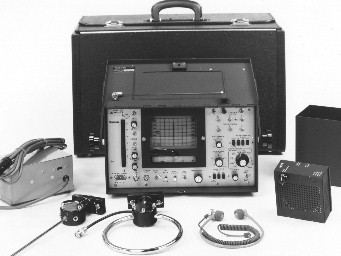
The Texscan AL51 proved to be a ready replacement for the 6060. Some modifications were made in the hopes some potential customers would buy it from me. Its nomenclature was the 6060C. I supplied it with the antennas from the Sprague 610 and a 1079 audio power amplifier. The Texscan analyzer was later replaced by the Avcon PSA65C. 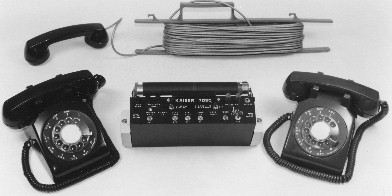 In the early 70s I was asked by a State Police agency to produce my first hostage phone, the 7080. It used rotary dial telephones because at that time dial telephones would work both on dial and tone lines but touch-tone telephones would not work on dial lines. It came with a bunch of wire, connectors and clips to meet virtually every situation. The 7080 has been battle tested at many prison riot and hostage situations. The latest version still looks the same but it contains up-to-date technology. 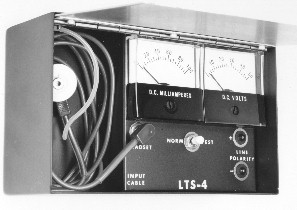
During the "hay days" of my business, people were bugging (pun) the heck out of me for a simple telephone line test. The LTS-4 answered most of their concerns. It measure line voltage and loop current and line audio. Didn't sell that many but it worked and looked neat. 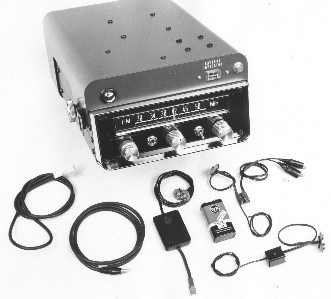 Talk about an old timer. This Lafayette hybrid (tubes and transistors) receiver filled the temporary gap between fully tube and fully transistor receivers. It had very good sensitivity and a wide-band I.F. Shown with it are the BT50 body transmitter (50mW), RT5 room transmitter (5mW) and TT5 telephone transmitter (5mW). During the "hay days" of the business I produced thousands of the little units. They were self-excited (no crystal) but stayed close to their 42MHz frequency once installed.
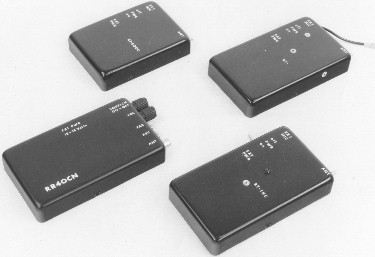 Shown here are the RR40CN pocket receiver and a 100mW, 500mW and 1W companion transmitter. The receiver pushed the state-of-the-art limits on sensitivity... better than .05uV. Its I.F. band width was 2Khz and in those days, the lower the better. They were fully transistorized but current hogs. 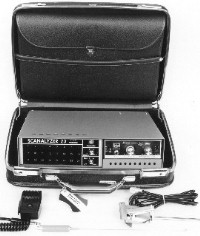
The SCAN23 had its place in time. During the U.S. Capitol grounds riots of the early 70s hand held Citizen Band (CB) transceivers were the communicators of choice for the so called "left." There were so many radios on the air at one time that all 23 of the CB frequencies were usually occupied. The Capitol Police came to me and asked if I could build a device that would indicate transmitter operation on all frequencies all at once. Scanners were out of the question. Thus, the SCAN23 was born. It simultaneously indicated all frequency usage instantly. The unit contained a broadband receiver covering all channels and individual filters which, when activated, would turn on a light for that channel. The police could then watch the light panel and a "leftist" to see which light came on when he or she lifted their transceiver to talk. That channel could then be monitored and "neutralized." A portable CB transceiver was included in the package should the Capitol Police wish to do just that. 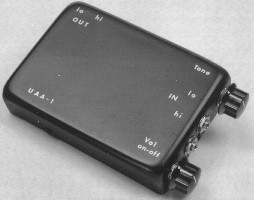 The UUA-1 (Utility Audio Amplifier-1) came out of the Intelligence Material Development and Supply Office (IMDSO) at Fort Holabird, Maryland. During the mid 60s it was the state of the art... albeit relatively crude. It contained a few transistors and transformers. I probably produced a few hundred. Then came its replacement, my 1059. Once my 1059 caught on, it was good-bye UAA-1. |
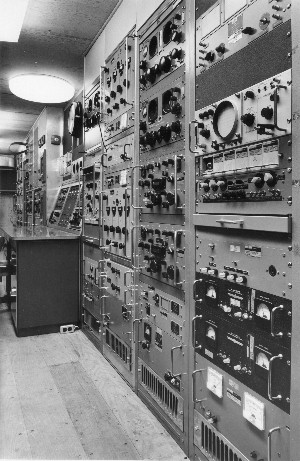
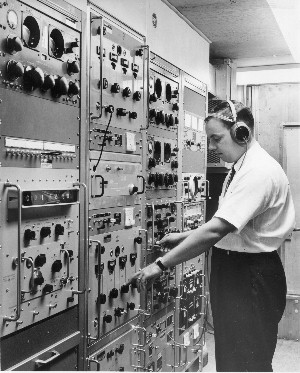 |

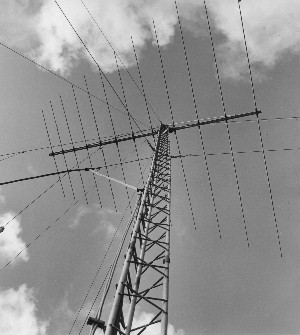
|
|
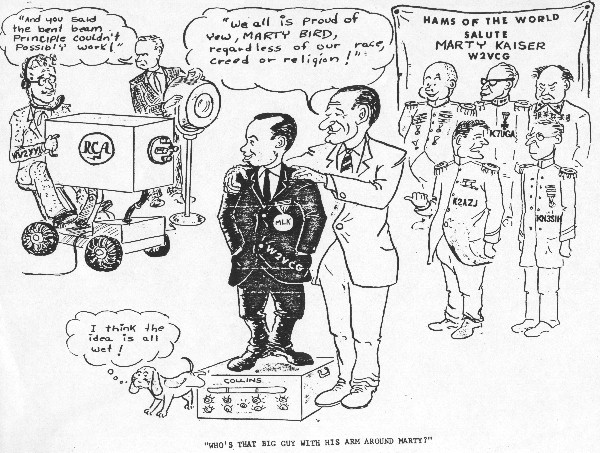
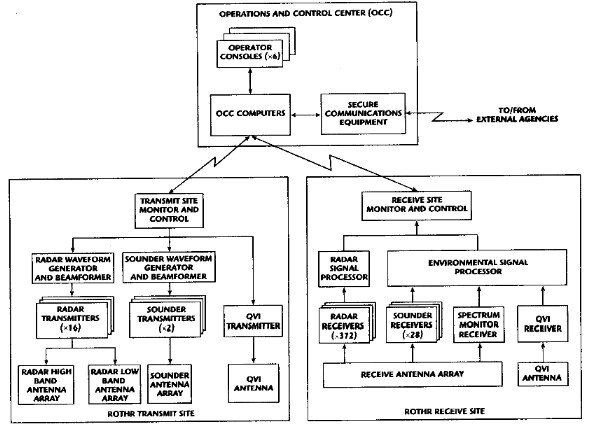 COLD WAR TO COUNTER DRUG
A small twin-engine airplane flies low over the water to avoid radar detection. At an undisclosed Caribbean airfield, two men
waiting by a truck signal that it is all clear to land. The plane lands and the men quickly begin to offload its cargo. To their surprise, they are met by government agents.
All three men are taken into custody; the plane and its cargo, 10 bales of cocaine and a briefcase of money, are seized without incident.
"What happened?" the pilot thought to himself. "Everything was perfect tonight." Little did he know that from 1000 miles away an advanced early-warning, over-the-horizon
radar was watching his entire trip and relaying his position to government agents who were moving to intercept him.
SWORDS TO BADGES
Originally, ROTHR was developed for the US NAVY to provide wide area ocean surveillance for the nation's fleet defense from both sea and mrborne threats. The first
engineering-development system was tested in Virginia and delivered to the Navy's Fleet Surveillance Support Command in 1988. The system then was transported to Amchitka,
one of the Aleutian Islands located 1300 km off the coast of Alaska, for operational evaluation. The tactical military radar scanned the skies from Japan to the eastern
USSR looking for high speed bombers: ROTHR perfonned its surveillance duties successfully and the Navy intended to install 12 of these systems around the world to provide
the fleet with an early warning of Soviet attick.
With the collapse of the Soviet Union and the decline in defense spending, it was uluikely that such a deployment of ROTHR systems ever would occur. However, while testing the
first production system, the radar operators noticed that ROTHR was not only travking large commercial aircraft crossing the Caribbean, but also small twin and single engine planes. On May 1, 1989, ROTHR provided the joint Coast Guard/Customs center in Miami with critical detection infonnation that led to an involved chase and the seizure of an aircraft carrying drugs to the Bahamas. This drug bust was the first one attributable to a long-range radar system. At approximately the same time, Congress assigned the Department of Defense with the role of counter-drug detection and monitoring and, as a result, the Pentagon decided to leave the ROTHR system at its test site in Virginia to search for drug traffic in the Caribbean.
Since that time, the ROTHR Virginia system has been operating as part of the national counter-drug strategy in conjunction with the ship and airborne assets of the Navy, Customs,
Coast Guard and local law enforcement agencies. A second ROTHR counter-drug surveillance site was installed in Texas in 1995. Together, these systems monitor 8.5 million square
kilometers of air and sea space from Mexico to Columbia to the islands of Trinidad and Tobago, as shown in Figure 1. More than 60,000 flights in this region are tracked each year.
Most of these flights involve innocent private or commercial lurcraft, but a small percentage are carrying narcotics toward the borders of the US. When the air route of a plane
raises the suspicions of ROTHR operators, infonnation on the target is passed to the Joint Interagency Task Force in Key West, Florida via a secure communications link. This agency, which is commanded by a us Coast Guard admiral, is the regional dispatcher of the
counter-drug effort in the Caribbean. Since 1992, information obtained by ROTHR has contributed to the seizure of over 50,000 kilograms of narcotics and tens of millions of
dollars in cash and resources. ... Article continues... See March 1998 Microwave Journal, Vol. 41, NO. 3
The Relocatable Over-the-Horizon Radar (ROTHR) is a proven long range surveillance radar in service with the U.S. government, deployed to
detect and track aircraft and ship targets at ranges to 2500 nautical miles.
The ROTHR system has been operational with the U.S. government for over 15 years, supporting the counter drug mission in the Caribbean Sea and South America, and early warning
detection for Navy vessels at sea. Each radar provides in excess of 2.5 million square miles of coverage area resulting in extremely low operational costs. Each ROTHR system
operates 24/7/365 and detects in excess of 350,000 targets per year. It is currently the U.S. government's primary surveillance system for the counter drug mission.
The ROTHR system uses ionospheric propagation to detect and track targets at all altitudes and on the surface. The extremely long detection ranges permit a large amount of
flexibility in the siting of each individual system to accommodate performance while achieving mission requirements. Each system can be remotely deployed and controlled by a
single Consolidated Operations Control Center (OCC) that is located at the user's convenience. All systems data is shared to provide a seamless transition of tracking information.
The OCC can provide individual radar tracks that are fused, processed and reported to higher command levels or to a fully integrated sensor network.
Raytheon is currently evaluating the use of ROTHR to provide Wide Area Surveillance for a National Coastal Surveillance System for Homeland Defense. As an operational and
deployed asset with ground-based results, ROTHR is a low risk and cost effective, proven solution for improving the security of the U.S. coastline.
|
2/18